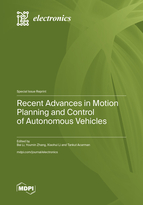Recent Advances in Motion Planning and Control of Autonomous Vehicles
A special issue of Electronics (ISSN 2079-9292). This special issue belongs to the section "Electrical and Autonomous Vehicles".
Deadline for manuscript submissions: closed (6 November 2023) | Viewed by 25474
Special Issue Editors
Interests: motion planning; computational optimal control; numerical optimization
Special Issues, Collections and Topics in MDPI journals
Interests: avionics and flight control for manned and unmanned aerial vehicles; monitoring; fault detection and diagnosis (FDD); fault-tolerant (flight) control systems; intelligent and hybrid control systems; UAVs and remote sensing techniques
Special Issues, Collections and Topics in MDPI journals
Interests: artificial intelligence; motion planning; control for intelligent systems
Special Issue Information
Dear Colleagues,
An autonomous vehicle refers to one that runs without a human driver. There has been rapid progress made in the applications of autonomous vehicles on a structured urban road or in an unstructured indoor scenario. Planning and control are two critical modules in an autonomous vehicle system. Concretely, the planning module is responsible for generating an open-loop trajectory, while the control module is to track the desired reference trajectory from the planning module in a closed-loop way and under all possible road, weather, disturbing driving conditions, including even abnormal conditions such as physical failures and cyberattacks. The planning and control modules are important as they directly reflect the intelligence level of an autonomous system. The purpose of this Special Issue is to present the most recent advances in the planning or control methodologies used for an autonomous vehicle. Submitted papers should focus on how the proposed planning and/or control method can solve real-world problems. The editorial board will maintain a high standard to prescreen the submissions which simply propose a generic method without sufficient discussions on its potential to address the real-world bottleneck problems in the community of autonomous driving. Note that we also welcome papers that discuss methods relevant to planning or control, as long as they can make the planning or control module perform better.
Topics of interest include but are not limited to:
- Path/trajectory/motion planning and replanning;
- Path/trajectory/motion control;
- On-road/off-road planning and control;
- Modeling and simulation method for planning and/or control;
- Testing and validation method related to planning and/or control;
- Safety-related issues with planning and control;
- Security-related issues with planning and control;
- Human–machine interaction related to planning and/or control;
- Intelligent techniques/methods to planning and/or control;
- Integration of planning and control;
- Reviews of planning or control methodologies;
- Data-driven/model-based planning or control;
- Comparisons among different types of planning or control methods;
- Fault-tolerant planning and control;
- Cooperative planning and control;
- Real-world applications of planning and control.
Prof. Dr. Bai Li
Prof. Dr. Youmin Zhang
Prof. Dr. Xiaohui Li
Prof. Dr. Tankut Acarman
Guest Editors
Manuscript Submission Information
Manuscripts should be submitted online at www.mdpi.com by registering and logging in to this website. Once you are registered, click here to go to the submission form. Manuscripts can be submitted until the deadline. All submissions that pass pre-check are peer-reviewed. Accepted papers will be published continuously in the journal (as soon as accepted) and will be listed together on the special issue website. Research articles, review articles as well as short communications are invited. For planned papers, a title and short abstract (about 100 words) can be sent to the Editorial Office for announcement on this website.
Submitted manuscripts should not have been published previously, nor be under consideration for publication elsewhere (except conference proceedings papers). All manuscripts are thoroughly refereed through a single-blind peer-review process. A guide for authors and other relevant information for submission of manuscripts is available on the Instructions for Authors page. Electronics is an international peer-reviewed open access semimonthly journal published by MDPI.
Please visit the Instructions for Authors page before submitting a manuscript. The Article Processing Charge (APC) for publication in this open access journal is 2400 CHF (Swiss Francs). Submitted papers should be well formatted and use good English. Authors may use MDPI's English editing service prior to publication or during author revisions.
Keywords
- motion planning
- path planning
- trajectory planning
- motion control
- path tracking
- trajectory tracking
- autonomous driving
- unmanned system









